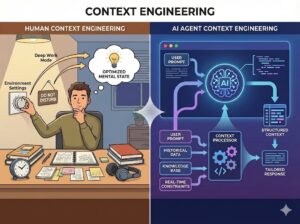Summary Insight:
Your AI strategy dies without single-point ownership. Appoint one leader to drive from today’s stage to the next—fast—so AI amplifies execution, not entropy.
Key Takeaways:
- Name a singular owner (Big Implementer/Single-Threaded Owner) with authority, budget, and a cross-functional team.
- Manage to the stage: Pilot → Nail It → Scale It, targeting a centralized AI brain + real-time knowledge graph.
- Structure first: place the leader in Quadrant 3, strip competing accountabilities, and report weekly through SET.
Last week, Harvard Business Review ran a viral piece: “Your AI Strategy Needs More Than a Single Leader.”
Well-meaning, but wrong.
The truth is your business absolutely does need a single leader to drive AI adoption. Without one, you’ll drown in committees, diffuse accountability, and stall progress.
At Organizational Physics, we call this leader the Big Implementer—one highly capable person leading a small cross-functional team and driving the project to stage-complete.
At Amazon, they call this role the Single-Threaded Owner—one person weaving the thread through all the functional “needle eyes” required to pull a project together.
Pick your metaphor. The principle is the same: for any mission-critical initiative to succeed—especially enterprise AI adoption—one individual must be accountable for driving it to completion.
In this article, I’ll show you how to choose that leader and set them up for success.
Choosing the Right Leader for Enterprise AI Adoption
Before you can pick the leader, you need a shared vision of what success looks like. (If you haven’t yet, read: In the AI Era, Success Goes to the Most Adapted.)
Then, the choice depends on your company’s stage:
-
Start-up: The CEO must lead AI adoption. Why? Because (1) the CEO is already entrepreneurial and close to the action, and (2) the AI adoption curve is so steep and disruptive it can’t be delegated. The CEO’s role expands to become Chief Context Officer, which is something I’ll cover in a future article and course.
-
Beyond start-up: Select your most entrepreneurial leader with strong business and technical chops. Their current title is irrelevant. What matters is they can bridge business and technology and have the authority to act. This person should report directly to the CEO and sit on the Strategic Execution Team.
This won’t always be your CTO, CIO, or Head of Analytics. Those roles may support the adoption, but the AI leader must be entrepreneurial, highly capable, and stage-focused.
Where to Place the AI Leader in the Structure
Until you’ve fully deployed a centralized AI brain and knowledge graph, the AI leader (if not the CEO) should sit in Quadrant 3: “Do the Right Thing for the Company.”
That means:
-
Full autonomy to ensure long-range viability.
-
Stripped of all competing accountabilities.
-
Authority to disrupt or upset existing functions if needed.
You can slot them into an existing role (like Innovation & R&D) or create a new one—Enterprise AI Adoption Lead—with its own charter and budget.
Understanding the AI Adoption Roadmap
The AI leader’s mandate: move the company from its current stage of AI adoption to the next major stage—no further.
If you’re tinkering with GPTs and agents in the Pilot It stage, their job is to push the org into Late Nail It—where you have a centralized AI brain and real-time knowledge graph.
Why stage by stage? Because goals, teams, and structures change with each phase—just as parenting a toddler differs from raising a teenager. Managing to the stage ensures focus and velocity.
| Stage | Features |
|---|---|
| Pilot It | • Individual use of ChatGPT and copilots • Isolated agent experiments • No shared context or integration • Early enthusiasm, scattered pilots • No clear ownership |
| Early Nail It | • First cross-functional pilots • Clear owner identified (Big Implementer / Single-Threaded Owner) • Early use cases tied to business processes • Some ad hoc data integration and improving rapidly • Initial awareness of risks and compliance |
| Mid Nail It | • Pilots expand across departments • Early AI business models forming • Focus on rapid integration of data pipelines • Exec team sees both value and friction • Experiments with knowledge graphs, not yet centralized |
| Late Nail It | • Centralized AI brain + real-time knowledge graph • Enterprise adoption roadmap established • Dedicated AI adoption team • Automated decision-making and workflows begin • Context-sharing between humans, agents, and systems |
| Early Scale It | • AI spreads across all functions • Governance, KPIs, OKRs tied to AI brain • CEO acting as Chief Context Officer • Org redesign removes structural bottlenecks • Predictive insights and adaptive processes |
| Full Scale It | • AI embedded in every workflow • Persistent context across humans + agents • Self-optimizing systems and learning loops • Governance and ethics institutionalized • Proprietary data and execution speed as moat • Company operates like an adaptive neural network |
Just in case it wasn’t clear, I am NOT proposing that one leader leads to the next micro-stage, NOT from early Nail It to mid Nail It for example, but to the next major stage such as Nail It into Scale It.
Building the Team and Executing Fast
The AI leader forms a small, cross-functional team with a budget, a deadline, and clear accountabilities.
-
Team reports weekly on progress at the Strategic Execution Team meeting.
-
Membership depends on scope, but must blend business process and technical leaders.
-
The team must be protected from governance drag (Quadrant 4) while keeping the company safe.
Execution speed comes from:
-
The leader’s drive and capacity.
-
Elimination of competing accountabilities.
-
The organization’s shared consciousness that this project is mission-critical.
Weekly reporting keeps obstacles visible and removable.
Summary
Your company’s AI adoption requires one singular leader—Big Implementer, Single-Threaded Owner, call it what you like.
This leader must be:
-
Entrepreneurial, with deep business and AI understanding.
-
Stripped of competing accountabilities.
-
Positioned correctly in the structure.
-
Supported by a temporary cross-functional team.
Their job is to drive enterprise AI adoption to completion—defined as advancing to the next lifecycle stage. At that point, another leader may take the mantle for the next stage.
That’s how you avoid entropy and ensure AI becomes a driver of scale, not chaos.
📌 P.S. Most AI breakdowns aren’t about the tech. They’re about the structure behind it.




